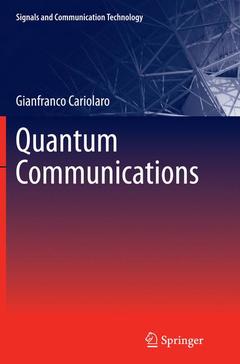Description
Quantum Communications, 2015
Signals and Communication Technology Series
Author: Cariolaro Gianfranco
Language: English
Subjects for Quantum Communications:
89.66 €
In Print (Delivery period: 15 days).
Add to cartPublication date: 10-2016
Support: Print on demand
Publication date: 04-2015
673 p. · 15.5x23.5 cm · Hardback
Description
/li>Contents
/li>Biography
/li>Comment
/li>
This book demonstrates that a quantum communication system using the coherent light of a laser can achieve performance orders of magnitude superior to classical optical communications
Quantum Communications provides the Masters and PhD signals or communications student with a complete basics-to-applications course in using the principles of quantum mechanics to provide cutting-edge telecommunications. Assuming only knowledge of elementary probability, complex analysis and optics, the book guides its reader through the fundamentals of vector and Hilbert spaces and the necessary quantum-mechanical ideas, simply formulated in four postulates. A turn to practical matters begins with and is then developed by:
- development of the concept of quantum decision, emphasizing the optimization of measurements to extract useful information from a quantum system;
- general formulation of a transmitter?receiver system
- particular treatment of the most popular quantum communications systems?OOK, PPM, PSK and QAM;
- more realistic performance evaluation introducing thermal noise and system description with density operators;
- consideration of scarce existing implementations of quantum communications systems and their difficulties with suggestions for future improvement; and
- separate treatment of quantum information with discrete and continuous states.
Quantum Communications develops the engineering student?s exposure to quantum mechanics and shows physics students that its theories can have practically beneficial application in communications systems. The use of example and exercise questions (together with a downloadable solutions manual for instructors, available from http://extras.springer.com/) will help to make the material presented really sink in for students and invigorate subsequent research.
Gianfranco Cariolaro was born in 1936 and graduated in Electrical Engineering at the University of Padova (Italy) in1960. He received the Libera Docenza in Electrical Communication in 1968 and was appointed full professor in 1975. Presently he is Professor Emeritus of Optical and Quantum Communications at the Department of Information Engineering of the University of Padova. His main research interests are in the fields of data transmission, cellular radios, deep space communications, optical and quantum communications, He is the author of several books, in particular Unified Signal Theory (Springer, 2011) and has cooperated with several industries, among them: Telettra (now Alcatel-Lucent), Italtel, RAI (the Italian broadcasting company), Hewlett-Packard, Snell and Wilcox, BBC, ST Microelectronics, Philips, Jet Propulsion Laboratory of NASA, Eutelsat.
The text shows the student how to apply quantum mechanical ideas for the next generation of telecommunications technology
End-of-chapter problems and experiment together with worked examples help the student to assimilate knowledge stage by stage
Shows the reader how to apply theoretical knowledge of quantum physics and quantum information to practical telecommunications systems
Demonstrates the systematic application of the technique of “square root measurement” for the evaluation of the performance of quantum communication systems both in absence and in the presence of thermal noise, for both binary and multilevel systems
Solutions manual for problems provided to instructors as supplementary material
Includes supplementary material: sn.pub/extras
These books may interest you

Quantum Optics 83.43 €



